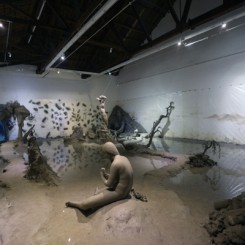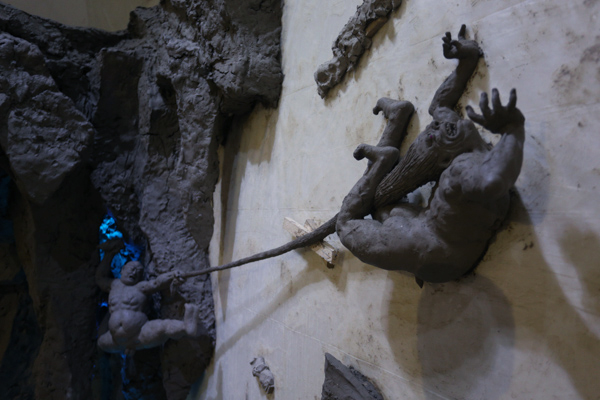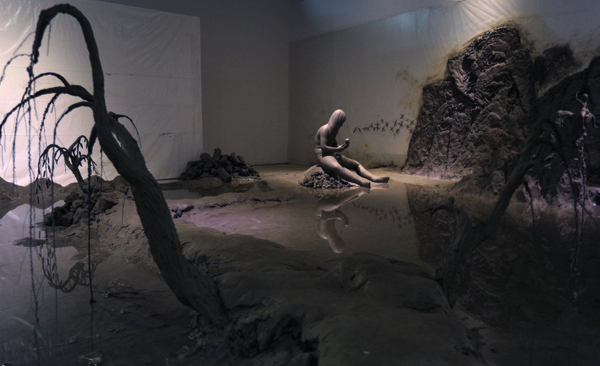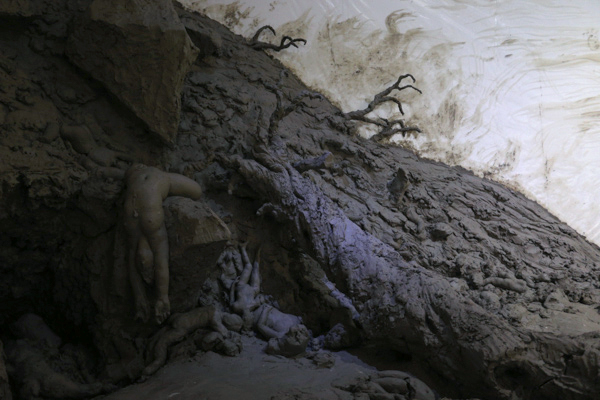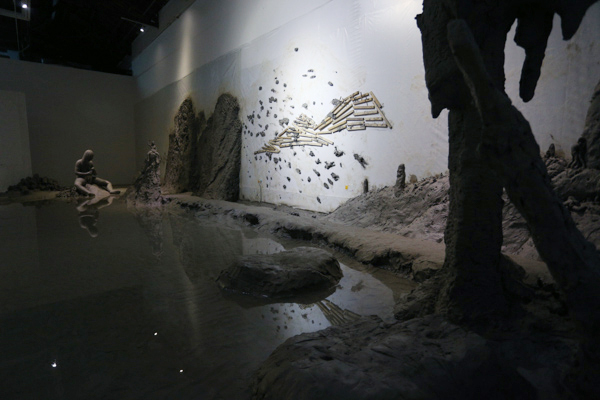“The Story of Beginning” – Liang Shuo solo exhibition
Space Station (Space Station, 4 Jiuxianqiao Rd,798 Art Zone, Chaoyang District, Beijing), Sept 26–Nov 2, 2014
If an exhibition represents an interaction between art and the viewer occurring within a physical space, then let us boldly enter the scene of the exhibition, open up our senses and our bodies to slowly savor all that is dispersed within; perhaps, in doing so, we will gain flashes of inspiration previously masked by our existing knowledge systems. Liang Shuo’s new show “The Story of Beginning” happens to be a space imbued with the possibility of “bodily perception.”
A graduate in sculpture from the China Central Academy of Fine Arts, Liang Shuo possesses the technical mastery of a traditionally educated sculptor, but since he commenced his Migrant Workers series in 2000, the artist has hidden his manual dexterity. This exhibition seems to mark Liang’s return to sculpture. Setting up a “creative space” in the style of a theme park, the artist has formed a mishmash of literary aesthetics and academic realism with clay—the most primitive of all materials—and the prototypical myth of Nüwa. Naturally, there is much to discuss about this type of experimentation. Before the opening ceremony had even finished, a flood of photographs of the exhibition was already hitting WeChat “Moments”; some expressed awe at the artist’s ability to sculpt on-site within such a short time frame, while others marveled at the varied scenes and narrative Liang Shuo was able unfurl, and more still favored the abundant charm of his vivid clay sculptures. All of these reactions stand to reason, but placing Liang Shuo’s new work in the limited confines of sculpture seems to narrow its rich implications. So let us clear our heads, and forget everything we know about Liang Shuo for the moment. Free from the influence of our knowledge, let’s step into “The Story of Beginning”.
The scent is what greets us even before we step into Space Station. The slightly cool vapor carries with it the subtle scent of clay, which breaks through the city’s smog and disperses in the pores—this is not a smell usually encountered in contemporary art. Upon entering the exhibition hall, a moist and humid world unfolds before us. The white walls of the gallery transform into a prehistoric land immersed in an expanse of muddy water; clay paths amassed at the foot of the four walls form a walkway of sorts for the audience—such is the route the artist has planned for his viewers. The story of Nüwa unfolds along this pathway; clusters of clay scenes are embedded within the twists and turns of the space, faint streaks of clay on the walls resemble Mi Youren’s distant mountains. A subtle literary air exudes from this scene, which is taken from a prehistoric universe. Situated in a conspicuous position is a sculpture of Nüwa mending the pillars of heaven reminiscent of kitschy pseudo-monuments in a theme park. By combining primitive materials, literary scenes and the “scum” aesthetics of theme parks, Liang Shuo has intertwined the threads of three subjects he has been involved with in recent years.
If we assume that Liang Shuo is re-examining Realist sculpture developed from a Western perspective, walking into this world, we get the sense that the artist is more concerned with the viewer’s act of stepping into “The Story of Beginning” than what is actually being sculpted. From the moment we breathe in the vapors and enter the scene, we can’t help but lower our heads to pay close attention to that narrow, uneven path beneath our feet. Our toes grip the wet and sticky ground as we fight for balance while attempting to avoid bumping into the clay sculptures beside us. Humble clay confronts us on all sides, reminding us of its existence in a manner that bypasses the visual, and aims straight for our bodies and our more primal senses. Quickly, we must come to understand the physical properties of mud and align ourselves with them. Clay is deceptively easy to mold, as it is filled with innumerable uncontrollable unknowns. Liang Shuo’s greatest pleasure is in contending with these controllable and uncontrollable elements.
Piled beside the clay path and the sculptures are accumulated pools of mud which beggar expression. From an angle of sculptural language, these pools of mud blur the depicted scenes and comprise time and space; they could contain millennia within their depths, or encompass a thousand miles of nature. That eternal prehistoric moment of myth is conveyed through the chaos of mud, and it must be said that this is the nourishment Liang Shuo has drawn from traditional painting and literature. What’s more interesting are the sudden appearances of hindquarters and thighs on the muddy path; perhaps they are the remains of victims—devoured by wild animals or crushed by landslides or earthquakes. Viewers with slow reflexes find themselves treading down upon these body parts, which sink right into the mud; within a span of a few days, these remains will return, indistinguishable, to the mud. On one side, human figures continue to appear from Nüwa’s hands, while on the other side, they are perpetually being trampled into the mud to become part of the path. Clay has been placed in a kind of intermediary state between the main body and the environment; it is the world in which we exist and that which forms our bodies. Perhaps this is where the poetic and allegorical nature of clay resides.
Looking at Nüwa—the first sculptor in heaven or on earth—it is clear Liang Shuo has stripped her of all the romanticism a prehistoric myth might be entitled to. Legs akimbo, she sits alone on an ancient earth, her fleshy limbs, bulging mid-section, and casual posture recalls nothing so much as a peasant woman sitting on a bed-stove, busy with her sewing.
So resolute as to appear fixated, one after another, she creates human beings out of boredom, clinging to this act. Within the repetitiveness of her labors, she does not question the quality or meaning of life. After a while she finds the act of molding from clay too slow, and begins simply flinging mud into the air. Though the myth traditionally describes these splatters of mud landing as fully formed human beings modeled on Nüwa’s likeness, Liang Shuo has shaped them into crude, half-human, half-toad creatures which cling to the walls. The lives of these organisms are cheap, merging with the ground if they fall into the clay or being devoured by wild beasts if they fall into the grass. Liang Shuo’s sculptural technique conveys a naked and primeval vulgarity, but behind it is a powerful message – life is the priority, the most important thing.
Over the years, Liang Shuo has made an effort to avoid emphasis on technical dexterity in his art, ridding himself of formulaic methods and tactics. As an artist with a background in sculpture, he does not devote himself to “sculpture” that can only be viewed from afar and never touched. Rather, he seeks an organic method of creation, coaxing out naturally arising interactions between material and environment, subject and object. Like Nüwa, Liang Shuo has on some level sidestepped the position of power occupied by the sculptor as Creator. By familiarizing himself and complying with the many limitations of the physical world, the artist allows natural and repetitive growth to replace a simple dichotomy of opposition and contention. His transformation of the Nüwa fable is no grand creation myth, nor is it the beginning of a linear history; instead, it points to the cyclical nature of life, and the insignificance of this cycle itself. Nüwa is not the protagonist of this tale, she is merely a cog that turns the wheel. Liang Shuo does not attempt to control the viewer’s experience, and instead bestows upon us the power to shape the world he has created. Consequently, the most subtle sculpture in this exhibition is not the goddess, but the clay path that we and Liang Shuo form beneath our feet—a sculpture both primitive and tentative, but supremely legitimate, nonetheless.

